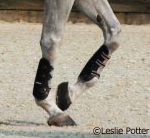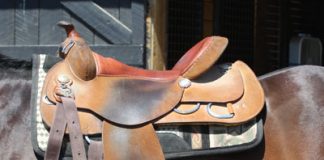 Wander the aisles of any tack store or browse the pages of a horse care catalog and you’ll be overwhelmed with the multitude of leg wraps and boots offered for sale. There must be a reason why there’s such a thriving industry of leg protection for horses, right?
Wander the aisles of any tack store or browse the pages of a horse care catalog and you’ll be overwhelmed with the multitude of leg wraps and boots offered for sale. There must be a reason why there’s such a thriving industry of leg protection for horses, right?
When using any type of boot or wrap, it’s always better to be well versed in their proper use. Here are seven suggestions on how to make the best of leg protection for your horse:
1. Use caution when applying any boot or wrap over a leg that has been rubbed or poulticed with liniment or DMSO. These products create warmth in the skin and tissues as well as a sensation of heat, which can build up when covered, especially during exercise or summer weather. That can lead to some nasty blisters. Consult your vet if you have any concerns about the topical products you’re using on your horse’s legs.
2. One size doesn’t necessarily fit all when it comes to horses and leg boots. This especially true with various styles of equine sports medicine boots. Too loose of a fit and they’re useless. Too tight and they can bind a horse’s leg. For these reasons, always read the manufacturer’s instructions, generally found on the package label. Measure your horse’s leg, including the circumference of the fetlock, to find the proper size.
3. With polo wraps, practice makes perfect. Ask your vet, barn manager or riding instructor to teach you how to correctly apply polo wraps. Sloppy, loose wraps can end up down around a horse’s fetlocks by the end of a workout, while over-aggressive wrapping can constrict sensitive tissues and create what’s called a “bandage bow.”
4. Fleece or knitted polo wraps aren’t the best choice for a lengthy trail ride that includes significant water crossings or lots of muddy terrain. Polos become soggy and heavy with moisture and loose their supportive qualities. A better choice for extreme trail rides are boots created from neoprene, the same stretchy, non-absorbent material used in wetsuits for divers and surfers.
5. Bell boots are inexpensive insurance against a nasty heel bruise or the loss of a front shoe. Both are caused when a horse over-reaches with their hind hoof and grabs the back quarters of their front hoof. Whether you opt for bell boots secured with Velcro closures or the pull-on variety, always check to make sure they fit your horse’s individual conformation. Some bell boots, particularly those made of stiff plastic, may chafe the back of a horse’s pastern, which can lead to painful open sores.
6. Wash your boots and wraps as necessary to prevent the potential of transferring bacteria or fungus from horse to horse, and also to remove build-up of arena dirt and grime. Virtually all are safe to wash in cool water with mild disinfectant soap. Then rinse thoroughly and allow them to air dry.
7. Before entering a competition with your horse wearing protective leg wraps or boots, check with show management to make sure such equipment is allowed. Rules vary from sport to sport. For example, jumpers and equitation horses may compete with certain types of protective leg gear, but hunters may not.
Leg protection is a wise choice for riders and horse owners who want to shield their horse from injury. For more information, click on these links to previous articles on Horse Channel: Polo Wrapping Done Perfectly and A Bunch About Bell Boots.







Thank you for posting this great information.
Thanks for the great tips! I use standing wraps on my pleasure horse and my trainer just recently showed me the correct way to apply them when she saw me doing it wrong. It really does take practice.
Nice, simple tips. I think many horses could benefit from boots/wraps for everyday protection on the trail or jumping/reining in the arena.
Thanks for posting this! So many people don’t realize how much they can do for their horses with something as simple as a pair of boots or wraps.
Great advice, thanks! However, it would be nice to get a comparison between the different types of wraps and their uses, too.
This was a great article! Very useful! Thanks horsechannel! I love the website!
Thanks.
good to re-enforce-horse play is rough stuff. thank you once again H.C.!!
Thanks! This article is very helpful to new horse owners that don’t know that much about boots and wraps. Thanks again!
good artical
I wash my horse’s boots using warm water, a stiff brush and horse shampoo. Horse shampoo is soap, so it will get the dirt and grime off, the stiff brush helps for those hard spots, and it is less likely to cause skin problems on your horse. I to the same thing with all my girths and cinches too.